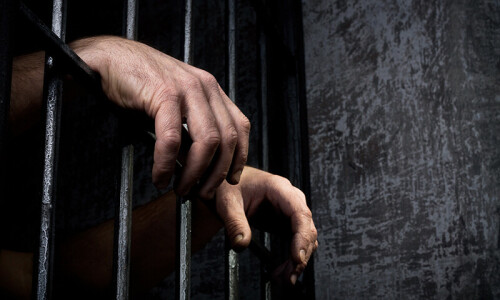For more than 150 years, Saddar Rawalpindi has been known for its commercial activities, but most people have failed to notice that the commercial centre is a reflection of the city’s religious pluralism.
It has a majority of the Muslim population, but Hindus and Christians have their share in the locality as well. A small stretch in the old Saddar Bazaar (Chota Bazaar) provides ample space for a temple, a church, several mosques, an Imambargah, and a Bohra mosque and community centre. Despite this, not a single religious quarrel has been reported there as all of them live peacefully and openly practice their religion for a century.
Krishna Temple
Near the Rawalpindi Railways Station, in Kabari Bazaar, there is an old building adjacent to a sacred fig (Peepal) tree which is the Krishna Temple — a place of worship for Hindus. It is the only functional temple for the Hindus of the twin cities of Rawalpindi and Islamabad.
Though there are many temples in the garrison city, the Krishna Temple is designated for Hindus due to the presence of only a few Hindus in the area. Constructed in 1897, the temple was built by Kanji Mal and Ujagar Mal Ram Rachpal. It was a small temple built to serve the people of the nearby area. However, after the partition, the small temple became the primary place of worship for the Hindus of Rawalpindi who opted to stay in Pakistan.
Chota Bazaar provides ample space for several mosques, temple, church, Imambargah, all located in close proximity
From 1947 to 1948, it was closed due to the partition violence. In 1949, the local Hindu Panchayat requested the authorities to open it for prayers. It was operated by the local Hindus, but the government handed it over to the Evacuee Trust Property Board (ETPB) in 1970.

The total area of the temple is less than five marlas. For its routine affairs, the temple is sufficient, but it is not big enough to accommodate crowds during festivals. The main room of the temple is decorated with an idol of Krishna, statues of Hanuman, and a Shivling or lingam installed in the room.
“Two prayers are held every day, in the morning and in the evening. Only a few devotees attend these prayers. Holi, Diwali, and other functions are held in the temple. There are more than 50 Hindu families residing in the garrison city, while Hindus coming from Sindh to Islamabad for jobs also come to this place for worship,” said Jai Ram, a priest at the temple.
Nicoll Memorial Church
A few metres away from the temple, at Ahta Mithu Khan, is the Nicoll Memorial Church where Christians gather every Sunday for prayers. The church is 98 years old and was constructed by the United Presbyterian Church.

“More than 100 Christian families reside in and around the Saddar area and mostly use this church for their prayers,” said Farid George, a member of the Christian community in Saddar. He said that there was no restriction in this area and no religious quarrels had been reported in almost a century.
In the surrounding area, there are several mosques. More than 10 mosques in the area belong to different sects like Sunni, Ahle-Hadis, Deobandi, Shia, and Dawoodi Bohra.
A century-old Imambargah Fatmia is the oldest in the Saddar area. “It is more than a century-old Imambargah in Saddar, while the oldest Imambargah in Rawalpindi is Hifazat Ali Shah Imambargah in Bohar Bazaar, Rawalpindi,” said Qamar Zaidi, a Tehreek-i-Nifaz Fiqa Jaffariya spokesperson.

Dawoodi Bohras
The prominent community in Saddar is the Dawoodi Bohras, as the first Dawoodi Bohra settlers in Rawalpindi were invited by the East India Company to settle and do business in the newly established Northern Command Garrison of the British Raj. Surviving records suggest that the leaders of this community were actively involved in education and welfare projects in the city and had established a school for the general public in 1899.

Today, there are about 255 families in Rawalpindi and Islamabad. A majority of the community members reside in the Saddar Cantonment area and are involved in the trade of hardware and plywood. The younger generations have taken up professional careers and have excelled in the fields of medicine and engineering.
The Bohra mosque in the area is more than 130 years old and is still in its original condition. “It is the main centre of our community, and we have been offering all our religious rituals without any hurdles,” said Isa Jee, a trader in Saddar.
Another old mosque is Asar-e-Wali in the Old Wheat Market—Kank Mandi—near the Rawalpindi Railways Station at the backside of the temple, which is managed by the Auqaf department. There are two more old mosques in the area that are more than 100 years old.

Former District Nazim Raja Tariq Kiani said that Saddar was a symbol of religious pluralism since the British Raj. He said that all the communities—Muslims, Hindus, and Christians—lived peacefully in the area for centuries and had the best relations.
He said that apart from Saddar, such religious pluralism is also visible in the Lal Kurti area, where Hindus, Sikhs, Christians, and Muslims lived peacefully. “Saddar had a large population of the Bohra community who organised a mourning procession on Muharram 7, and they played a major role in the development of Saddar’s business activities,” he said.
He said that during the colonial period, Hindus, Sikhs, Christians, and Parsi were the main traders, but Muslims had only a few shops. However, after the partition of the Indian subcontinent in 1947, Hindus and Sikhs left the country, but many Hindus and Christians still live in the area.
Published in Dawn, March 24th, 2025
















































